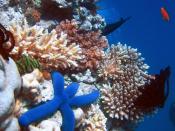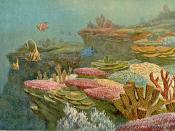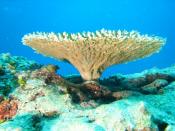Corals are simple and archaic animals called polyps. Their small body has a ring of tentacles that have stinging cells which help them catch small animals for food. Corals also have the ability to make skeletons for themselves out of limestone which in turn helps with support as well as the maintenance of reefs. The polyps usually grow upward, resulting in the expansion of their skeleton and as they grow they also divide by developing "identical twins," which also grow and divide. Corals usually need light to be able to grow because their bodies contain single-celled plant cells which use photosynthesis to grow. How much light corals can gather is one of the factors that determine their shape. Other factors that affect a corals shape is how they develop and the level of water on which they grow. Corals that grow on shallow water are usually sturdy, but those who grow deep enough and avoid the sunlight are usually thin and fragile.
Together, these corals form reefs.
The skeletons of the largest corals are long-lasting and form solid rocks. But nevertheless, all corals contribute to the building of reefs. When corals die, they become moldered into sand, which is usually swept into beaches by the waves.
There are three classes of reefs: atolls, barrier reefs and fringing reefs. Coral reefs grow much slower than the corals because unlike corals, reefs don't immediately erode away when they die. The growth rate is also slow because sand production is only a couple of pounds per every square yard a year.
Because coral reefs need light and don't like fresh water very much, they can only grow in particular places. They also don't like areas that have high-levels of nutrients and sediment which in turn prevents them from growing in oceans. Some of...


